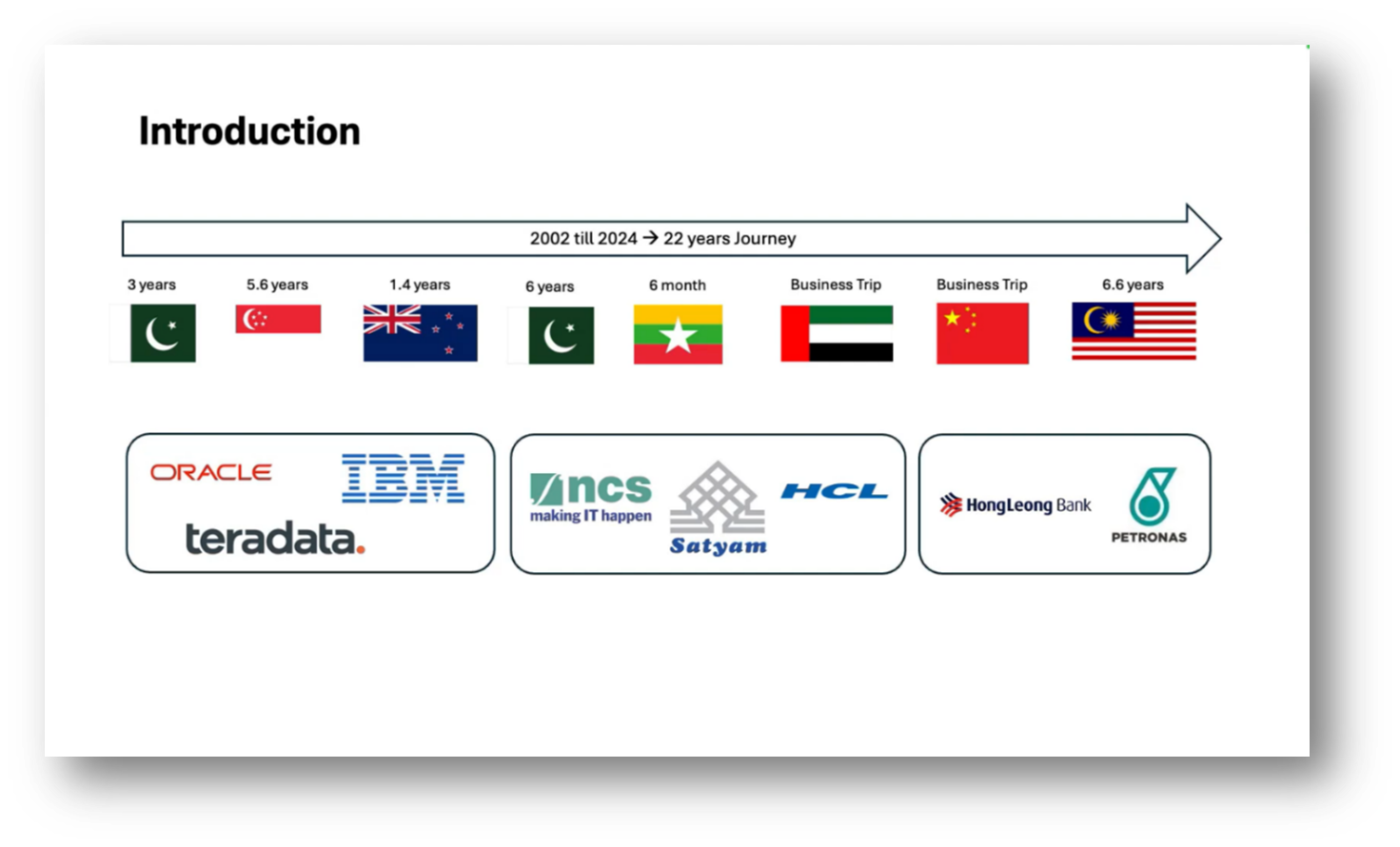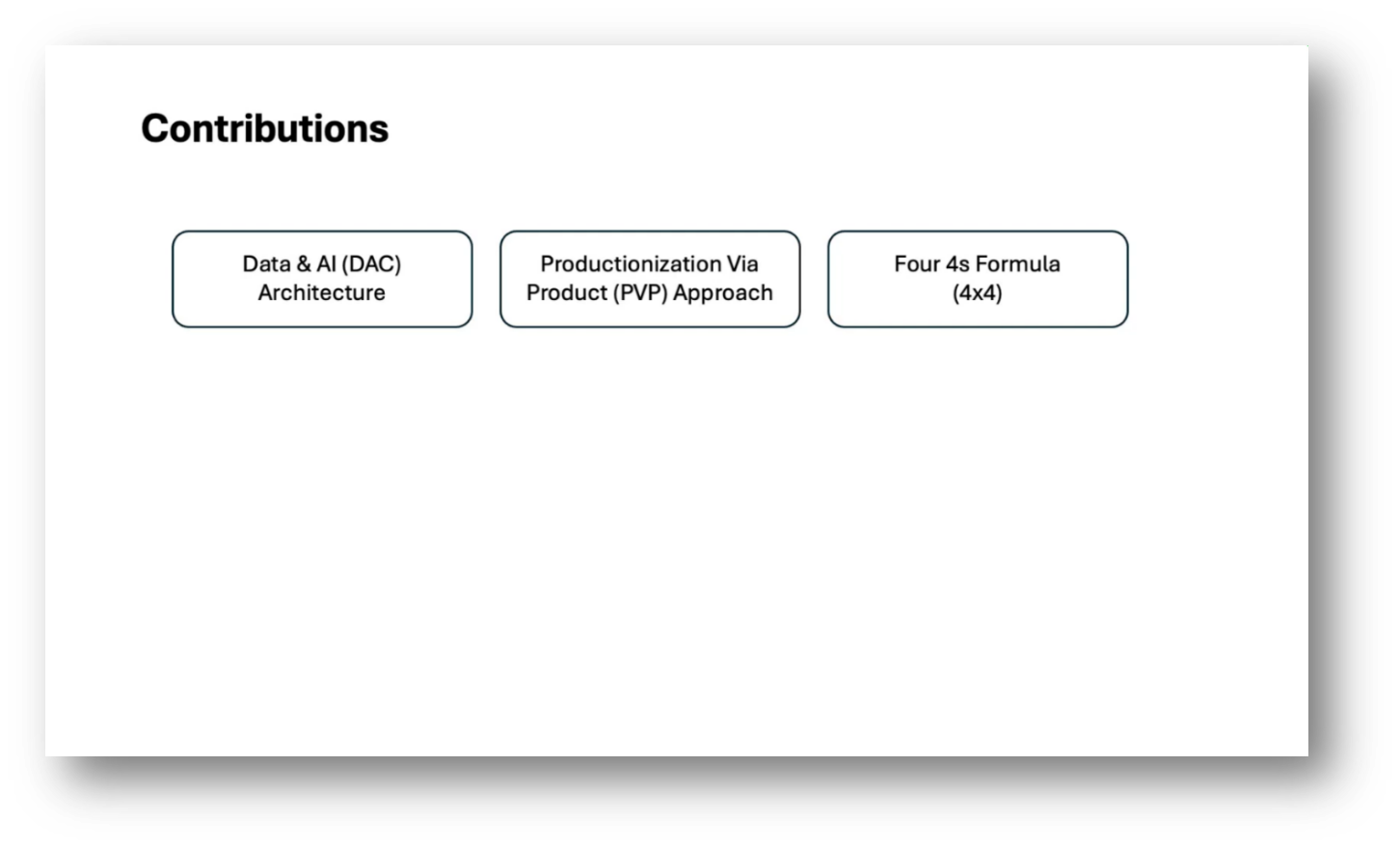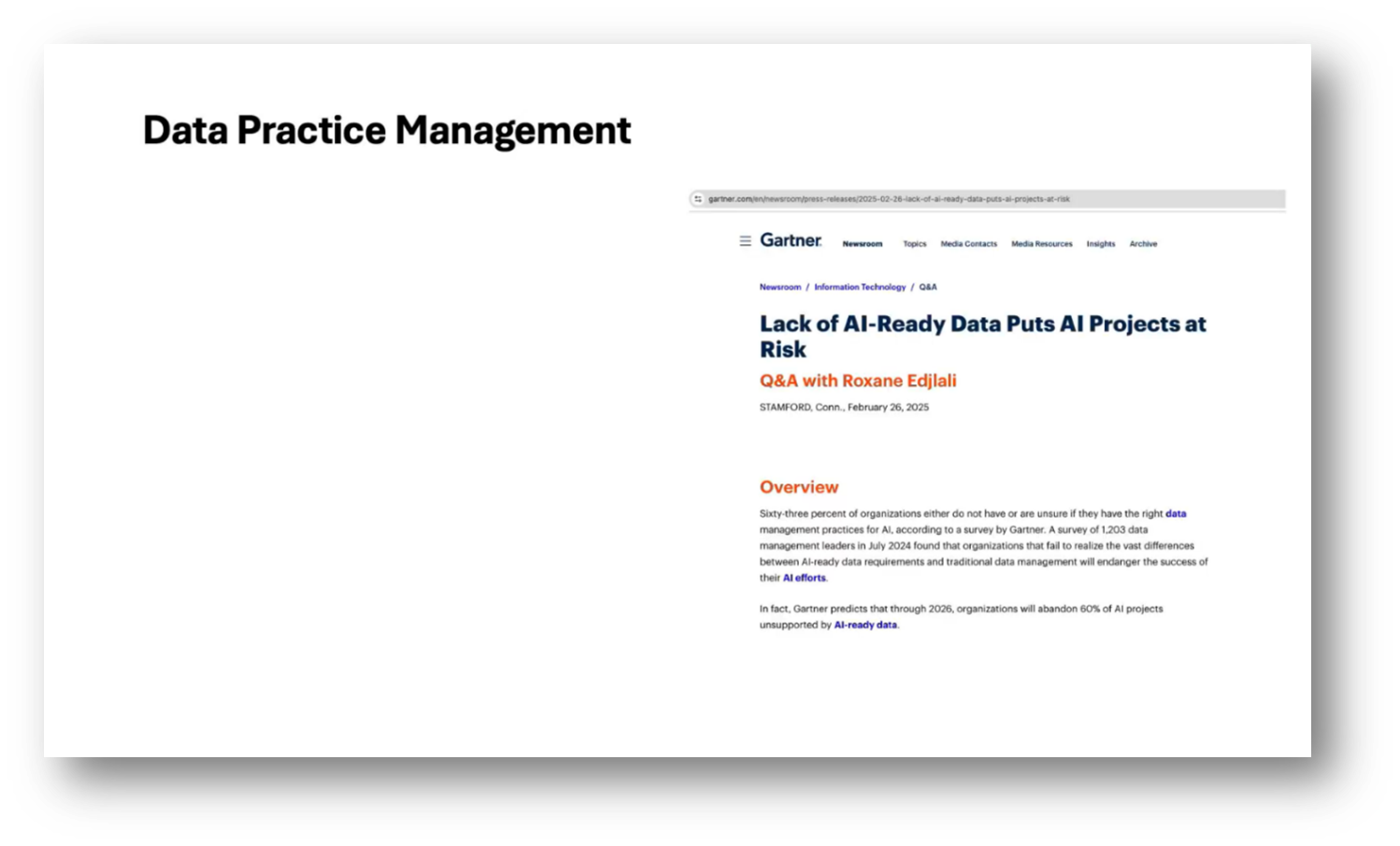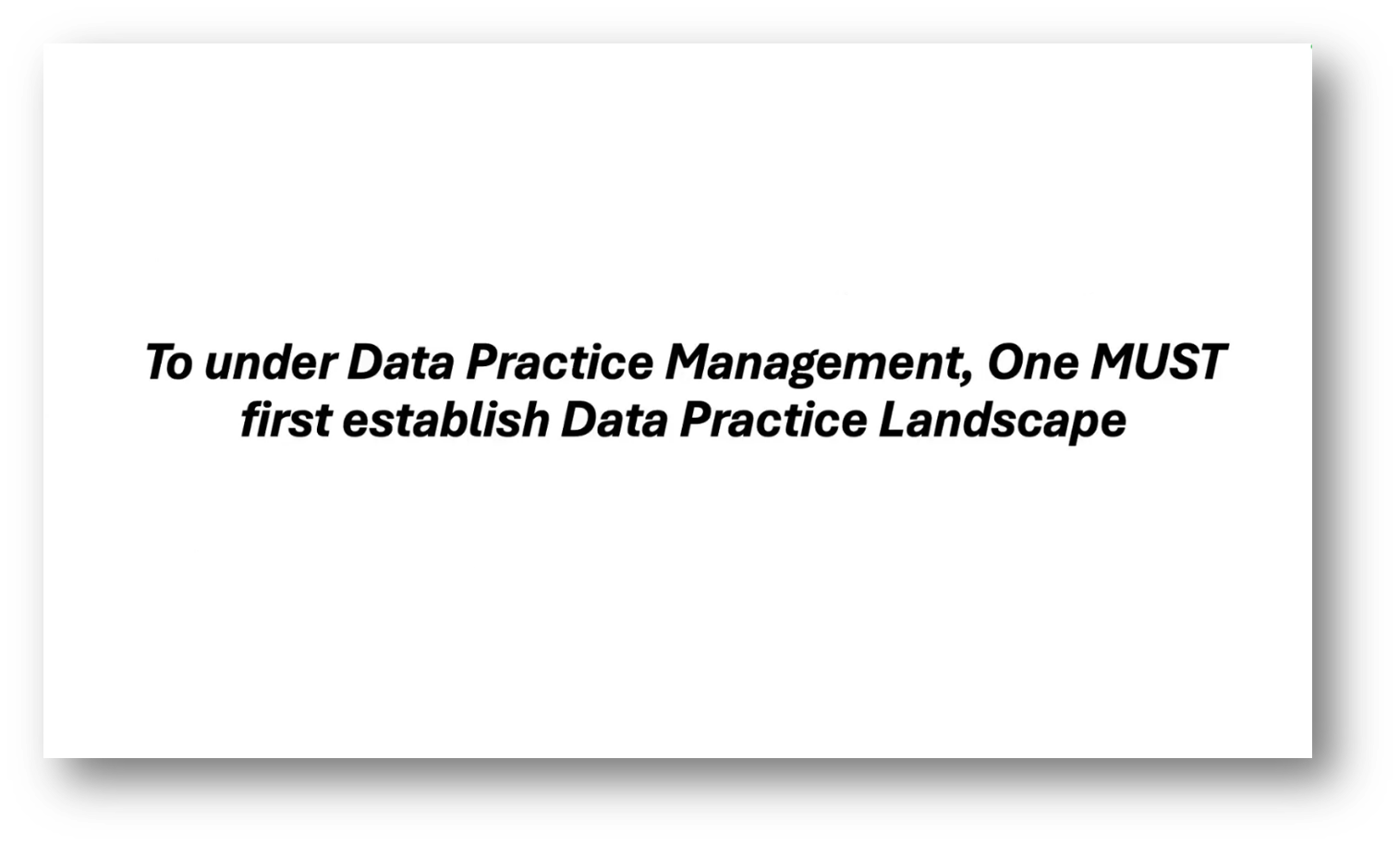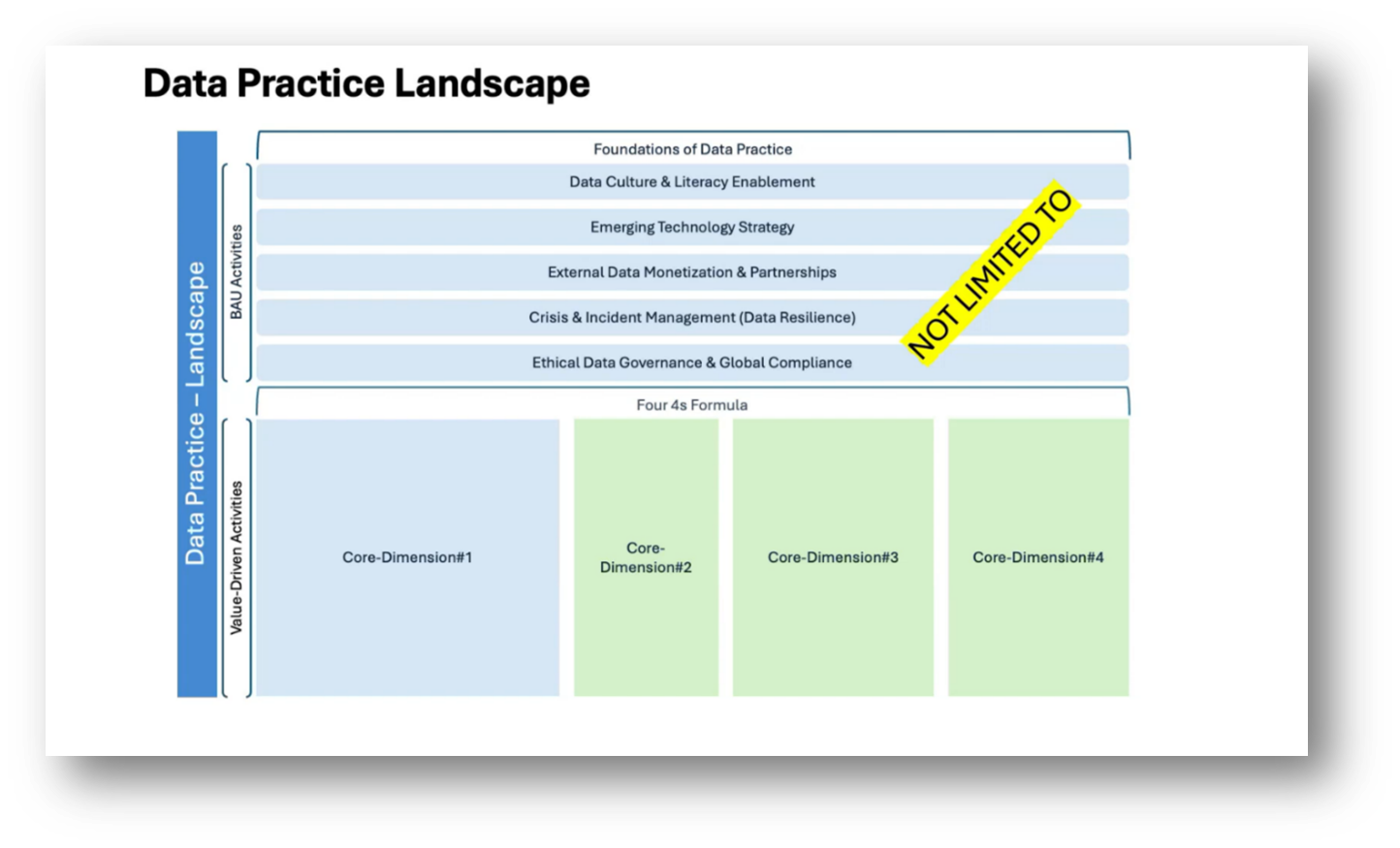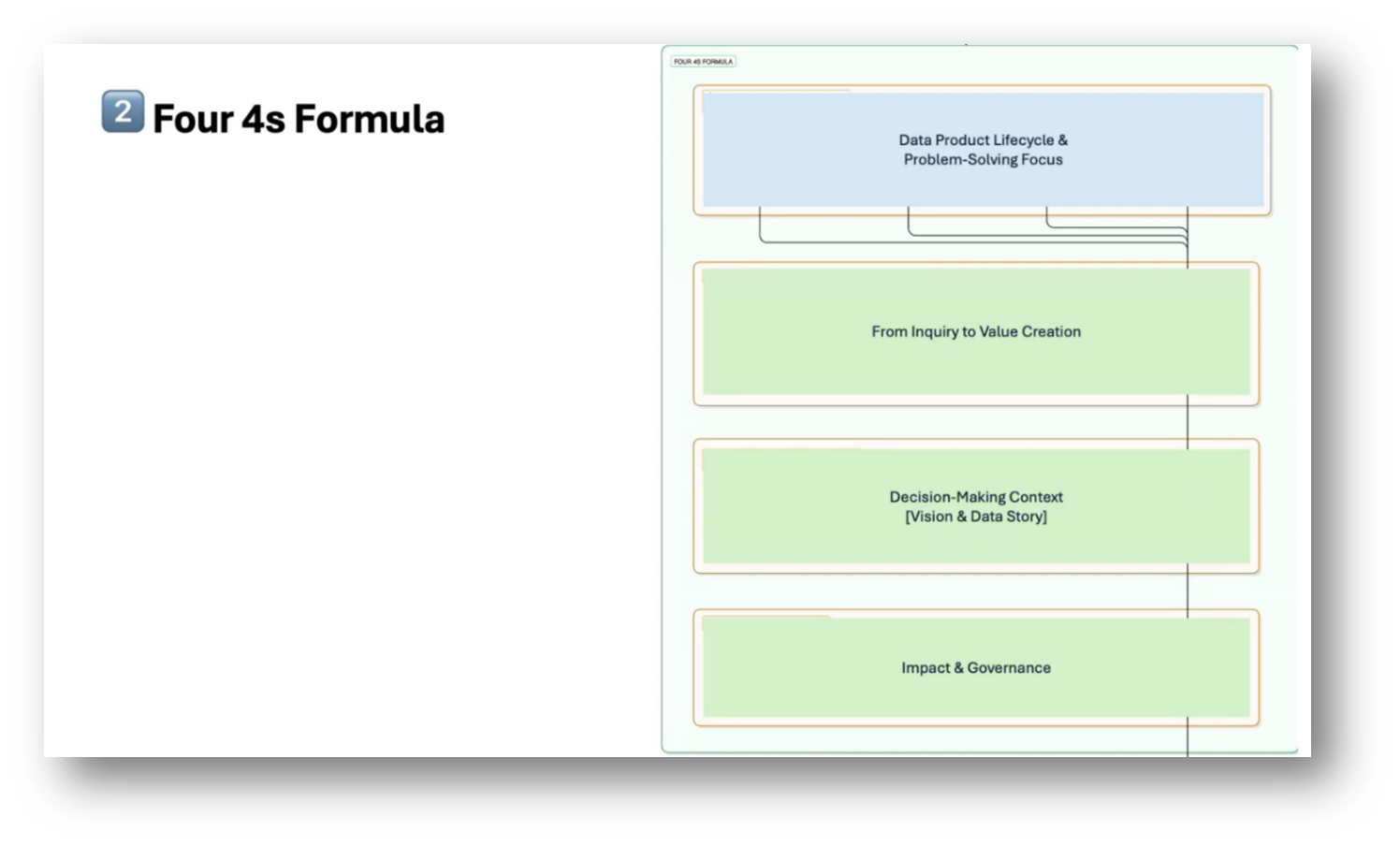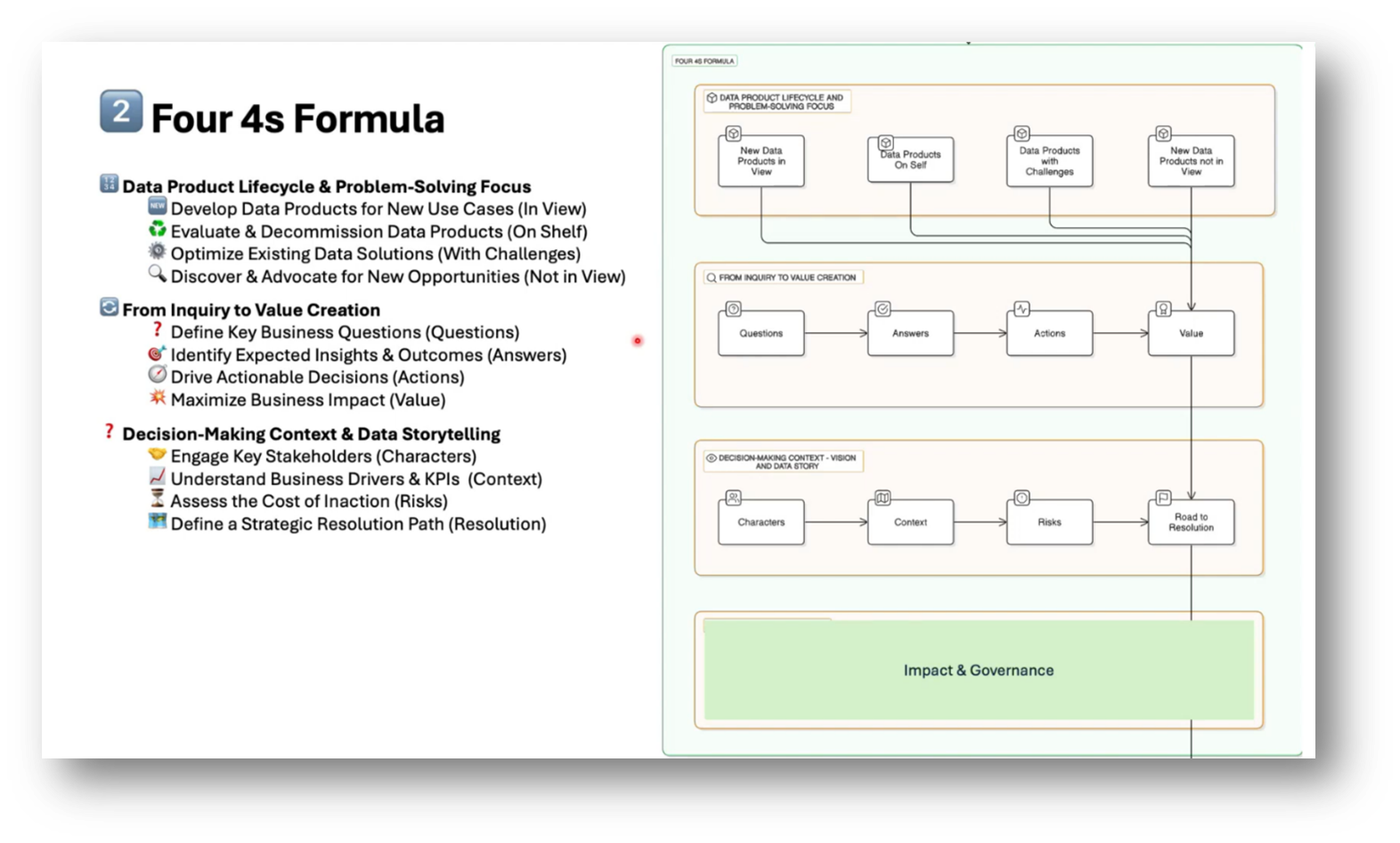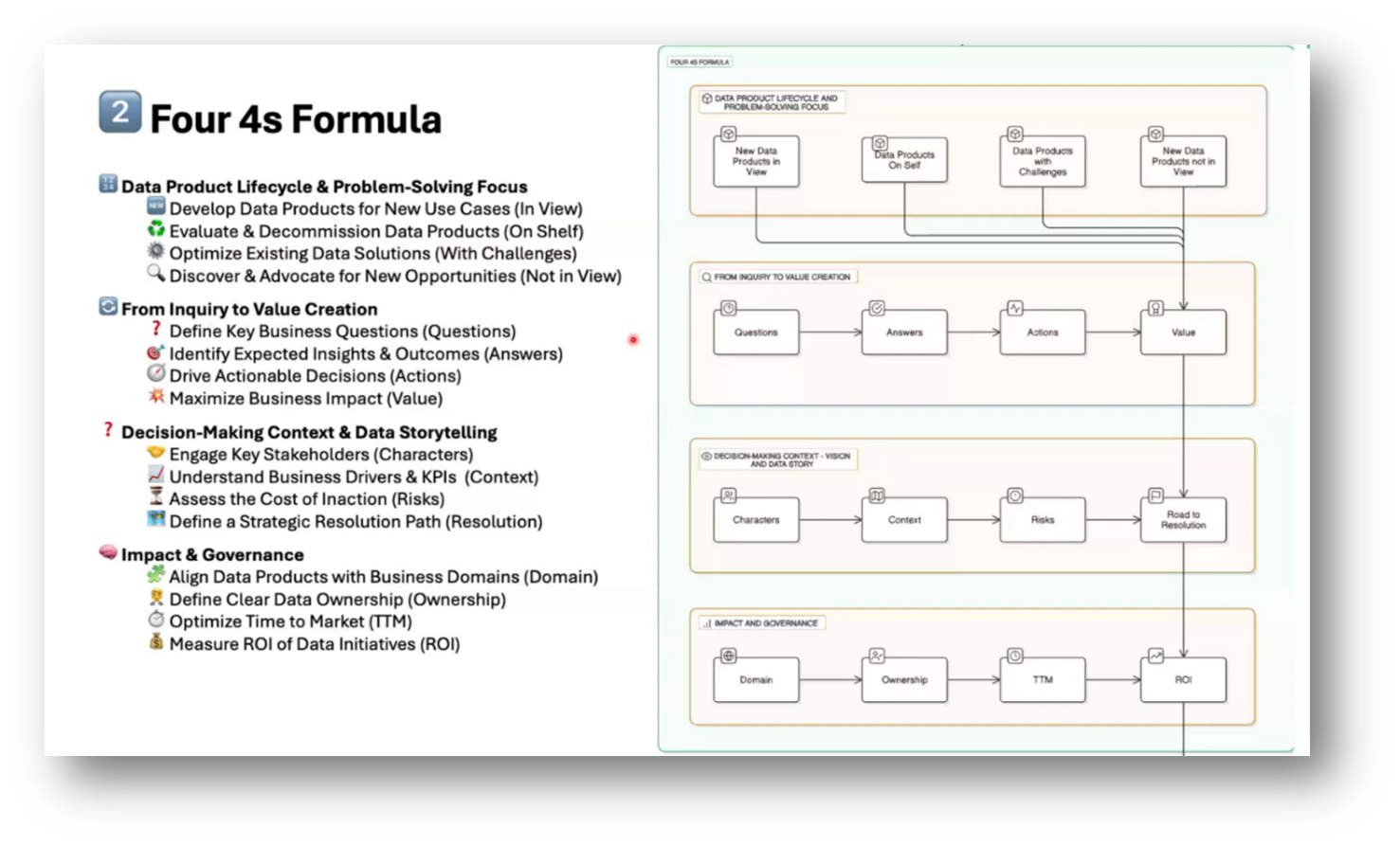Data Practice Management with Mustafa Qizilbash
Executive Summary
This webinar outlines the key themes of Mustafa Quizilbash's presentation on Data Practice Management. Mustafa addresses the crucial challenges and significance of Data Governance in AI projects. He introduces the 4X4 framework for effective Data Management, emphasising core dimensions and sub-dimensions that guide the prioritisation of data products within organisations. Additionally, the webinar covers essential considerations for creating data products, highlighting decision-making, value generation, and the importance of storytelling and risk management in product development.
Mustafa explores the roles of organisational personas in execution, the intricacies of data product development amid AI challenges, and the critical aspects of value creation in decision-making processes. Additionally, he discusses Master Data Management challenges, return on investment, and the importance of cultivating a data-driven culture and literacy within organisations. Ultimately, the webinar reinforces the integration of Data Governance and practice management for organisational success.
Webinar Details:
Title: Data Practice Management with Mustafa Qizilbash
Date: 17/03/2025
Presenter: Mustafa Qizilbash
Meetup Group: DAMA SA Big Data and Data Science
Write-up Author: Howard Diesel
Contents
A Journey Through Data with Mustafa Quizilbash
The Agenda for Mustafa’s Presentation on Data Practice Management
The Challenges and Importance of Data Governance in AI Projects
Managing Data Practice and the 4X4 Framework
Core Dimensions and Sub-dimensions in Data Management
Prioritisation of Data Products in the Organisation
Key Considerations When Creating a Data Product
Decision-Making and Value in Business
The Role of Storytelling and Risk Management in Product Development
Organisational Personas and Roles for Product Execution
Data Product Development and AI Challenges
Value Creation in Data Management and Decision-Making
Data Management in Business
The Challenges of Master Data Management
Return on Investment and Active Benefits Recognition Measurements
Data Quality and Management Mindset in Organisations
Data Quality and Governance in Organisations
Data Culture and Data Literacy
Data Culture, Data Governance, and Data Practice Management
A Journey Through Data with Mustafa Quizilbash
Howard Diesel opens the webinar and introduces Mustafa Qizilbash, a data expert and author of ‘I Am Datapedia!’, which offers updated data definitions akin to a dictionary. Additionally, Howard adds that Mustafa has extensive experience in the Data Management field and is also known for his channel, "Let's Talk Data."
Mustafa expresses gratitude for the opportunity to share his insights on data, acknowledging the importance of accurate information in this evolving landscape. He adds that his presentation will focus on data practice management within organisations, emphasising the distinction between managing data and the reality of data platforms and practices.
With 22 years of experience in the data field, Mustafa has worked internationally in countries such as Singapore, New Zealand, Myanmar, Dubai, China, and, currently, Malaysia. He has collaborated with major vendors such as Oracle, IBM, and Teradata. Mustafa notes that he has developed his own data architecture, known as DOS Architecture, and a revised approach called PvP. Additionally, he has authored "I am Datapedia," a resource containing over 330 data-related topics, and hosts a weekly podcast featuring experts from around the world, fostering discussions on data and AI.
Figure 1 Data Practice Management Cover Image
Figure 2 Disclaimer
Figure 3 Introduction
Figure 4 Contributions
The Agenda for Mustafa’s Presentation on Data Practice Management
Mustafa shares the agenda of the presentation. It focuses on data practice management, highlighting its importance in today's rapidly evolving AI landscape. Additionally, it touches on recent Gartner data indicating that 63% of organisations lack confidence in their Data Management practices, underscoring the need for a structured framework. Mustafa adds that he will define data practice management as a comprehensive approach to managing, governing, and optimising data across an organisation, from collection to business value realisation. Other Key points, he adds, include the necessity of transforming data for competitive advantage, addressing the shift from centralised to federated data approaches, balancing agility with governance, and navigating emerging challenges such as regulatory pressures and ethical considerations. Lastly, Mustafa wants to cover effective data practice management that supports sustainable growth, innovation, and responsible data usage.
Figure 5 Contributions pt.2
Figure 6 Agenda
Figure 7 Data Practice Management
The Challenges and Importance of Data Governance in AI Projects
According to Gartner, over 50% of AI projects fail, with projections indicating that up to 80% of data AI initiatives may not succeed by 2027; a significant factor contributing to this failure is poor Data Quality, which affects 85% of projects. Mustafa notes that Data Quality is subjective and varies based on specific requirements. He adds to this by highlighting the importance of thorough requirement gathering and planning.
As organisations adopt more decentralised Data Governance structures, the challenge of managing numerous data products increases. Unlike traditional governance that focuses on time and budget, effective Data Governance must adapt to ensure quality—especially in critical scenarios. This necessitates a blend of centralised governance and decentralised operations, prompting a more tailored approach to Data Quality across different product domains.
The complexity of governance over data, particularly in the context of AI, is increasing significantly due to evolving compliance requirements and the limited overlap between traditional compliance and Data Management functions. Finding compliance officers with a strong understanding of Data Management is challenging, highlighting the need for mature data practice management.
Mustafa notes the transition we are making into an era of AI dominated by autonomous agents and purpose-built data projects. He adds that it is, presently, crucial to address risks associated with fragmented Data Quality, governance blind spots, and AI biases. Mustafa suggests that implementing robust data practice management will ensure high-quality, reusable data products, accountability, and lifecycle ownership, consolidating efforts under a unified framework for better clarity and coordination.
Figure 8 Problem Statement
Figure 9 Problem Statement pt.2
Figure 10 Problem Statement pt.3
Figure 11 "Why we need mature Data Practice Management"
Figure 12 To Understand Data Practice Management, One Must First Establish A Data Practice Landscape
Managing Data Practice and the 4X4 Framework
To effectively manage data practices, Mustafa suggests first understanding the data practice landscape, which can be broken down into two main components: foundational Business As Usual (BAU) activities and the value-driven activities defined by a 4x4 framework. BAU activities encompass ethical Data Governance, global compliance, incident management, and data culture enhancement, forming the core operations conducted by Chief Data Officers (CDOs) and data leaders.
The 4x4 framework includes four core dimensions: the data product life cycle and problem-solving focus, the transition from inquiry to value creation, data storytelling in decision-making contexts, and impact governance. Together, these elements facilitate a transition from traditional, centralised data practices to a more value-driven culture that emphasises use cases and federated approaches, ensuring ongoing compliance and ethical management of data.
Figure 13 Data Practice Landscape
Figure 14 Flow Diagram (Two Pillars)
Figure 15 Four 4s Formula
Core Dimensions and Sub-dimensions in Data Management
In the data industry, organisations typically categorise their data products into four dimensions, focusing on the product life cycle and problem-solving. Mustafa notes that a significant issue arises when data products are implemented but remain unused, often referred to as "sitting on the shelf," with studies suggesting that up to 75% of such products fail to deliver return on investment (ROI).
Data leaders and CDOs must prioritise identifying non-utilized data products while also addressing challenges faced by high-value products already in production. These challenges may stem from technological advancements or performance issues due to increasing data volumes, which can lead to extended processing times. It is crucial for data leaders to address these issues to ensure the optimal functioning and value realisation of data products.
The third focus area involves developing data products for specific use cases where businesses understand their requirements but are uncertain about the appropriate technology to adopt, especially in an era of rapidly evolving data solutions and technologies. CDOs and data leaders play a crucial role in addressing these needs by guiding businesses in choosing the right technologies. Additionally, they are responsible for discovering and advocating for emerging opportunities by identifying new use cases in the global market, ultimately providing businesses with more efficient and cost-effective solutions. Mustafa adds that these initiatives can run in parallel based on organisational priorities, with some entities emphasising the introduction of new products while others may concentrate on reducing costs through the decommissioning of outdated data products.
Figure 16 Four 4s Formula pt.2
Prioritisation of Data Products in the Organisation
Mustafa discusses the flexibility in prioritising data product visibility, emphasising that organisational needs dictate focus, whether it's on shelf products or new use cases. An attendee points out that challenges arise from the lack of documentation when data products are used inconsistently, often leading to crises when these products are removed. Additionally, they stress the need for thorough analysis before decommissioning any product, as changes could enhance its value. Mustafa then recommends a tool called YOOI. It leverages the organisation's data with the help of AI.
Key Considerations When Creating a Data Product
In developing a data product, Mustafa notes that it is crucial for businesses and stakeholders to first identify the key questions they wish to answer. Understanding the expected answers to these questions is essential, as it guides the actions to be taken based on the insights gained. This process involves four critical steps: defining the questions, anticipating the answers, outlining actionable steps, and ultimately assessing the value generated from these actions. The significance of this framework is underscored by Shane Gibson's Information Product Canvas, which offers a structured approach to requirement gathering with its 12 canvases. This method emphasises that to create a valuable data product, intentional actions must be based on data-driven insights.
Figure 17 Four 4s Formula pt.3
Decision-Making and Value in Business
Effective Decision-making in business is essential as these decisions will represent actions derived from responses to inquiries about products or services. Mustafa goes on to say that the importance of understanding the implications and efforts associated with these decisions can often be underestimated.
To illustrate his point, Mustafa mentions a complexity calculator he created to quantify the cost of projects, which helps stakeholders evaluate the genuine value against their budget. Additionally, he touches upon the necessity of aligning value with expenses, as profit margins play a significant role in determining whether a project's benefits justify its costs, ultimately tying back to the concept of ROI.
The Role of Storytelling and Risk Management in Product Development
The process of product development involves several key steps that begin with identifying the foundational objectives, such as decommissioning or enhancing the product based on known or emerging business use cases. After defining these objectives, it is essential to outline the questions, answers, actions, and the value the product will deliver. Creating a compelling narrative includes identifying stakeholders and establishing a clear vision for the product while considering the cost of inaction as a critical risk factor.
An effective roadmap for implementation should encompass Domain Ownership, Time to Market (TTM), and ROI calculations, ensuring that the product can generate significant value relative to its development costs and timelines. Additionally, Mustafa adds that shortening TTM can lead to an earlier realisation of ROI, making thorough planning crucial before embarking on the product journey.
Figure 18 Four 4s Formula pt.4
Figure 19 Organisational Personas
Organisational Personas and Roles for Product Execution
Mustafa outlines the four main organisational personas involved in the execution of data products: strategic leadership, executive roles, business roles, and enablement roles, including governance and transformation positions. Key examples of these roles include CEO, Chief Data Officer (CDO), Chief Analytics Officer (CAIU), heads of governance, data stewards, product owners, business analysts, and data scientists.
Typically, Mustafa notes, CEOs focus on the value new products can deliver, prioritising implementation context, associated risks, and domain relevance (such as procurement, finance, or marketing), as well as TTM and return on investment (ROI). It is important to recognise that the approach to the roles of CEO, CDO and CAIU may vary significantly across different organisations, making it essential to tailor engagement strategies accordingly.
Figure 20 Organisational Personas & Their Interests in the Four 4s Formula
Data Product Development and AI Challenges
The need to critically evaluate ideas before moving forward with business cases emphasises the importance of the ideation step in data product development. An attendee adds to Mustafa’s point by highlighting how probing questions can help determine the viability and importance of proposed concepts. Additionally, this may potentially save time and resources by avoiding decisions driven solely by enthusiasm or loud advocates.
The second core dimension mentioned, from inquiry to value creation, stresses that while a concept may initially seem profitable—like a product projected to generate $100 million—further analysis often reveals significant costs involved, necessitating careful decision-making to ensure realistic outcomes.
The current landscape of AI products is rapidly evolving, with organisations seeking to integrate structured data into Large Language Models (LLMs) like ChatGPT, which primarily handle unstructured data. Data leaders and Chief Data Officers (CDOs) play a crucial role in identifying suitable technologies for businesses that have clear use cases but may lack knowledge of the latest solutions.
Mustafa notes that as technology matures, it's essential to be cautious about time-to-market (TTM) and return on investment (ROI), with companies now expecting a tenfold value increase rather than the traditional two or three times. Additionally, the fast-paced development of new, more efficient technologies necessitates continual adaptation, indicating that multiple iterations may be required before achieving the desired ROI.
Value Creation in Data Management and Decision-Making
Several approaches emerge from an inquiry made towards Mustafa with regard to the value creation process. He suggests a primary focus on achieving better, faster, and cheaper data, decisions, actions, and resource utilisation. Additionally, while it’s recognised that one cannot achieve all three aspects simultaneously—better, faster, and cheaper—understanding trade-offs is essential.
Mustafa discusses the idea of shifting trade-off curves in economics to enhance returns. He emphasises the importance of Data Quality in decision-making, launching products, and reducing operational challenges. Furthermore, he touches on graph theory and its use in data modelling, specifically the Fully Communicated Orientated Information Model (FCO-IM) technique that is applied before logical modelling.
On the topic of approaching product development, Mustafa emphasises the importance of creating an implementation framework that begins with requirement gathering, specifically using Shane Gibson's information product canvas. According to Mustafa, Shane Gibson suggests developing distinct graph theories for different organisational domains, such as sales and marketing, ensuring these theories are aligned with business approval before product creation. Additionally, the process of building a product starts with data modelling, which requires adapting to rapid technological changes that can significantly impact the return on investment.
Mustafa then highlights the need for a strategic and flexible approach to data product implementation, advocating for smaller, more manageable data models within a layered data preparation structure, including landing, staging, and transformation layers. Ultimately, the goal is to foster greater value through smaller, achievable products, leveraging dimensional modelling techniques in the semantic layer.
Data Management in Business
A data-focused solution can offer businesses various value propositions, particularly timely data access and data understanding in decision-making processes. However, organisations face several challenges, including improper execution, difficulties in data mining, reliance on intuition without formal data, and high operational costs. Mustafa notes that the goal of data solutions is to help businesses address these issues by enhancing their decision-making abilities through granular data insights. Additionally, the focus may vary across organisations but often centres on areas where the most significant value can be added, which tends to align with common struggles in the consulting experience.
Data Quality often presents challenges in the interactions between IT and business, especially as both parties frequently operate under the misconception that the data is perfect. A key example Mustafa notes is the implementation of an SAP tool without ensuring the accuracy of the master data, leading to significant inefficiencies and increased costs while data was collected from multiple systems.
Mustafa stresses the importance of addressing Data Quality before investing in technological solutions, particularly in the context of Master Data, which is essential for enterprise-level decisions that involve multiple systems. However, he notes, for smaller products with fewer data sources, the necessity for Master Data may be less critical. Thus, data products can be categorised into enterprise products, requiring comprehensive Master Data for unified reporting, and business products, which may function well with minimal master data requirements.
The Challenges of Master Data Management
Master Data Management (MDM) is fundamentally about the agreed-upon definitions and processes surrounding data rather than being solely reliant on tools. Effective MDM is crucial, especially when dealing with data products that involve multiple sources, as it necessitates clear discussions and definitions. While the concept of finding a “golden record” is central to MDM, the implementation of comprehensive solutions can be complex and often costly, typically requiring significant organisational investment for shared benefits.
Many organisations struggle with fully implementing MDM, leading to challenges in achieving a satisfactory return on investment. Ultimately, Mustafa notes, MDM discussions and decisions are essential for successful Data Management and require collaboration across different stakeholders.
Defining terminology and maintaining centralised control over Data Management is critical to preventing issues in data lineage and reporting. Key challenges arise when changes made to small product fields lead to widespread confusion and misinterpretation, resulting in poor business decisions that negatively impact the entire system. Mustafa emphasises the need for a structured approach, such as a grown Master Data Management framework.
An attendee expresses their support for enhanced lineage tracking to provide clear visibility from the source data all the way to reports and dashboards. Mustafa suggests that automation tools can aid in both backward and forward lineage tracking, reducing issues that arise from misinterpretations of data usage further along in the process.
Return on Investment and Active Benefits Recognition Measurements
Active Benefits Realization (ABR) and traditional ROI measures are discussed. An attendee raises concerns about the often political nature of ROI, where metrics can be manipulated to justify pre-determined decisions. They suggest that ABR offers a more inclusive approach, focusing on formative assessment rather than absolutes, thereby encouraging broader participation in investment decisions. Mustafa adds to the attendees’ point by noting that there is growing skepticism regarding ROI's completeness and validity, leading to an interest in exploring ABR as a potentially more reliable alternative in evaluating investments.
Mustafa and attendees then examine the complexities of calculating return on investment (ROI) and the potential pitfalls in data interpretation for political decision-making. One example Mustafa shared involves a colleague's project where initial claims of high ROI, attributed to significant cost savings, were miscalculated. The actual savings derived from automating the work of two employees, rather than generating new value, was only a fraction of what was initially reported. This situation, Mustafa notes, underscores the necessity of a proper framework for calculating ROI, as well as the importance of distinguishing between cost reduction and actual value generation.
Data Quality and Management Mindset in Organisations
An attendee emphasises the critical connection between Data Quality and management mindset, referencing Peter Kang's concept of "I am my position," which highlights the risks of becoming overly identified with one's role. This mindset can hinder a broader perspective and obstruct necessary changes in Data Quality initiatives. Common issues arise when leaders prioritise appearances over addressing serious Data Quality problems. Additionally, Mustafa notes that Data Governance challenges could significantly hinder ROI on data products unless organisations adopt the right mindset.
Mustafa categorises Data Quality into two areas: standardisation rules for transforming data and more subjective quality measures like spelling corrections and calculations. He then highlights that senior data roles historically focused on Business-as-Usual (BAU) activities, which should now be more objective, while the focus should shift towards generating value in data practices.
Data Quality and Governance in Organisations
Challenges in Data Governance and Data Quality relate to Data Management, particularly the fear among individuals that raising issues might reflect poorly on them. This creates a culture in businesses where problems are masked, impacting data integrity. Mustafa emphasises the importance of understanding Data Quality standards, particularly when it comes to product representation and customer interactions. He points out that data flows between systems and through human conversations, and when the quality of data is deemed adequate for one purpose. Additionally, it may become inadequate for another, leading to contamination of information.
The need for clarity on data lineage and a centralised approach to product development is highlighted by Mustafa. Different requirements may necessitate the creation of tailored solutions rather than relying on pre-existing data that may not meet diverse needs.
Small data products within a larger ecosystem focus on specific actionable answers. Mustafa acknowledges that challenges posed by the organisational culture and individuals can hinder progress. He suggests a dialogue at the data level. This dialogue is essential to recognise and accept the varying quality of data from small products, especially when they are not widely utilised. Additionally, the participants must aim to address these challenges methodically, ensuring a thorough understanding of the impact of people on the product development process.
Data Culture and Data Literacy
Mustafa discusses the transition from a centralised to a federated approach in managing data products, emphasising the importance of data culture and literacy. He highlights that in a federated system, each data product must have its own defined questions and answers, rather than relying on a master data source typical of a centralised model. Additionally, this shift means that quality expectations vary based on the specific role and size of each product, as actions taken from the data are directly linked to the quality of the answers provided. Ultimately, the reliance on centralised data creation led to subjective quality assessments, which can no longer be expected in the same manner.
Data Culture, Data Governance, and Data Practice Management
Data culture has changed from a centralised approach, where IT is solely responsible for providing high-quality data, to a decentralised model involving small, autonomous teams managing their own data products while adhering to centralised governance practices. This cultural change, Mustafa notes, introduces the concept of a Data Practice Management team, responsible for overseeing the governance and quality of diverse data products.
By creating a blueprint of all data products, teams may ensure that each data product meets governance standards, preventing redundancy and enhancing effective Data Management and quality across the organisation. The implementation of Data Governance may be further supported by incorporating specific Key Performance Indicators (KPIs) to encourage teams to adopt and adhere to these practices.
Mustafa advocates for a centralised data practice management team that will bridge the gap between IT, DevOps, and business functions. This will ensure that teams are not solely project or support-focused but also business-oriented. Additionally, Mustafa notes that while data teams traditionally operate within an IT framework, integrating a business focus into all teams, including DevOps, is essential for effective communication and alignment with organisational goals. With multiple teams interacting with key organisational pillars like enterprise architecture, cybersecurity, and governance, a centralised approach with subject matter experts and business analysts is crucial for managing these connections successfully.
If you would like to join the discussion, please visit our community platform, the Data Professional Expedition.
Additionally, if you would like to be a guest speaker on a future webinar, kindly contact Debbie (social@modelwaresystems.com)
Don’t forget to join our exciting LinkedIn and Meetup data communities not to miss out!




